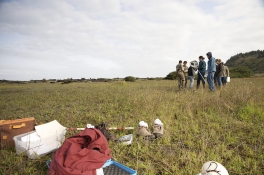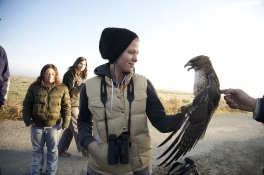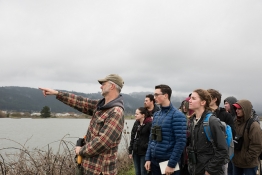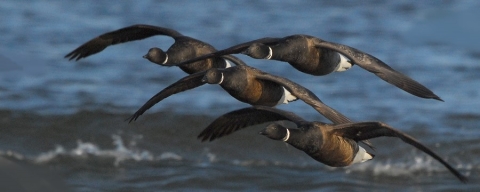The objectives of this study are founded on the working hypothesis that brant are grazing specialists that manipulate favored food stocks in such a way that optimizes foraging opportunities upon return to previously grazed sites. We predict therefore that Zostera communities and the black brant population interact on a temporal and spatial scale.
There are four primary objectives in this study:
- develop a temporal and spatial description of Zostera quality and abundance
- describe seasonal and annual Zostera phenology
- identify potential anthropogenic and natural factors responsible for variation in Zostera quality and abundance
- develop a temporal and spatial description of goose foraging distribution in relation to Zostera quality and abundance
Colleagues from Alaska have fitted black brant with tarsal bands that are readable with a telescope. Students will be encouraged to find and record individually marked black brant. In particular, participation will be expected from students in Waterfowl 420.
- For more information about these bands and how you can help record data, scroll down
Highlights
Shaughnessy FJ, Ferson SL, Frimodig AJ, Barton DC, Hurst M & Black JM 2021. Growth and flowering responses of eelgrass to simulated grazing and fecal addition by brant geese. Ecosphere 12:doi.org/10.1002/ecs2.3690
Stillman RA, Wood KA, Gilkerson W, Elkinton E, Black JM, Ward DH, & Petrie M 2015. Predicting effects of environmental change on a migratory herbivore. Ecosphere 6:art114.
Elkinton E, Lo L & Black JM 2013. Black Brant Branta bernicla nigricans forage at both tides on Humboldt Bay, California, USA. Wildfowl Special Issue 3, 90-103.
Spragans KA, Bjerre ER & Black JM 2013. Black Brant Branta bernicla nigricans grit acquisition at Humboldt Bay, California, USA. Wildfowl Special Issue 3, 104-115.
Shaughnessy FJ, Gilkerson G, Black JM, Ward DH, & M Petrie 2012. Predicted Zostera marina response to sea level rise and availability to foraging black brant in Pacific coast estuaries. Ecological Applications22, 1743-1761.
Black JM, Lee DE & Ward D 2010. Foraging home ranges of black brant Branta bernicla nigricans during spring stopover at Humboldt Bay, California, USA. Wildfowl 60, 85-94.
Lee DE, Black JM, Moore JE & Sedinger JS 2007. Age-specific stopover ecology of black brant at Humboldt Bay, California. Wilson Journal of Ornithology 119, 9-22.
Moore J & Black JM 2006. Slave to the tides: spatio- temporal foraging dynamics of spring staging black brant. Condor 108, 661–677.
Moore J & Black JM 2006. Historical changes in brant Branta bernicla nigricans use on Humboldt Bay, California. Wildlife Biology 12, 151-162.
Ward D, Reed A, Sedinger J, Black JM, Dirkson D & Castelli D 2005. North American Brant: effects of changes in habitat and climate on population dynamics Global Change Biology 11, 869-880.
Moore, J, Colwell M, Mathis R & Black JM 2004. Staging of Pacific flyway brant in relation to eelgrass abundance and site isolation, with special consideration of Humboldt Bay, California. Biological Conservation 115, 475-486.
Lee DE, Hamman MG & Black JM 2004. Grit-site selection of black brant: particle size or calcium content? Wilson Bulletin 116, 304-313.
Reading Black Brant Tarsal Bands







